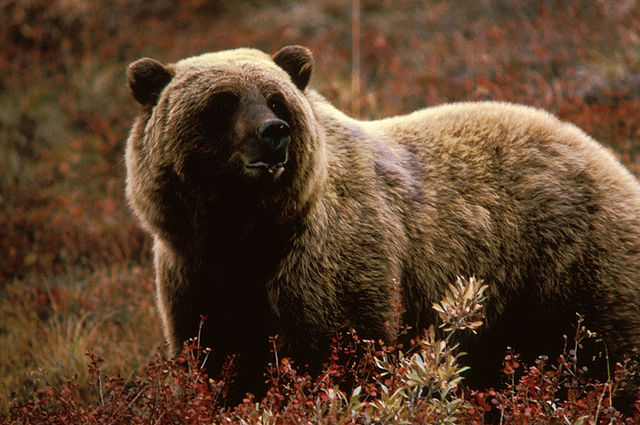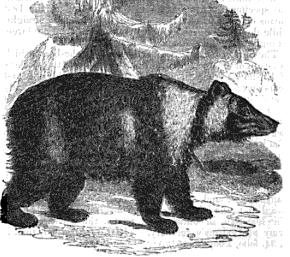Ordinary Bears
Brown Bear
Learning Objectives
Type your learning objectives here.
- First
- Second
Exercises
Type your exercises here.
- Go into the wild. Cook something that a bear would be attracted to. Wait for bears to arrive. Document the differences between the bears. Be cautious!
- Second
The brown bear (Ursus arctos) is a large bear with the widest distribution of any living ursid [1]. It is one of the two largest terrestrial carnivorans alive today, rivaled in body size only by its close cousin, the polar bear (Ursus maritimus). There are several recognized subspecies, many of which are quite well-known within their native ranges, found in the brown bear species.
Sub-species: The Grizzly Bear
The grizzly bear (Ursus arctos ssp.) less commonly called the silvertip bear, is any North American morphological form or subspecies of brown bear [2]. Scientists do not use the name grizzly bear but call it the North American brown bear.

Sub-species: East Siberian brown bear
The East Siberian brown bear (Ursus arctos collaris) is a subspecies of brown bear which ranges from eastern Siberia, beginning at the Yenisei river, as far as Trans-Baikaliya, the Stanovoy Range, the Lena River, Kolyma and generally throughout Yakutia and the Altai Mountains. The subspecies is also present in Northern Mongolia.[3]
East Siberian bears are intermediate in size to Eurasian brown bears and Kamchatka Brown Bears, though large individuals can attain the size of the latter. Their skulls are invariably larger than those of Eurasian brown bears, and are apparently larger than those of Far Eastern brown bears.[4] Adult males have skulls measuring 32.6-43.1 cm in length and 31.2-38.5 cm wide at the zygomatic arches. They have long, dense and soft fur which is similar in colour to that of Eurasian brown bears, though darker coloured individuals predominate. Originally, Cuvier’s trinomial definition for this subspecies was limited to brown bear populations in the upper Yenisei river, in response to bears there sporting well developed white collars. The subspecies has since been reclassified as encompassing populations formerly classed as yeniseensis and sibiricus, though the latter two lack the collar.[5] Siberian bears tend to be much bolder toward humans than their shyer, more persecuted European counterparts. Siberian bears regularly destroy hunters’ storages and huts where there is food.[6] They are also more carnivorous than their European counterparts, and do not seem to like honey. They hunt mountain hares and ungulates such as reindeer, wapiti or moose by ambushing them from pine trees.[7]

Examples
Type your examples here.
- First
- Second
Media Attributions
- Grizzly Bear
- East Siberian Brown Bear illustration
- Servheen, C., Herrero, S., Peyton, B., Pelletier, K., Moll, K., & Moll, J. (Eds.). (1999). Bears: status survey and conservation action plan (Vol. 44) . IUCN. ↵
- Schwartz, C. C., Miller, S. D. and Haroldson, M. A. (2003). "Grizzly bear". pp. 556–586 in G. A. Feldhamer, B. C. Thompson and J. A. Chapman, eds. Wild Mammals of North America: Biology, Management, and Conservation. Johns Hopkins University Press, Baltimore, MD. ↵
- Mammals of the Soviet Union Vol.II Part 1a, SIRENIA AND CARNIVORA (Sea cows; Wolves and Bears), V.G Heptner and N.P Naumov editors, Science Publishers, Inc. USA. 1998. ISBN 1-886106-81-9 ↵
- Mammals of the Soviet Union Vol.II Part 1a, SIRENIA AND CARNIVORA (Sea cows; Wolves and Bears), V.G Heptner and N.P Naumov editors, Science Publishers, Inc. USA. 1998. ISBN 1-886106-81-9 ↵
- Mammals of the Soviet Union Vol.II Part 1a, SIRENIA AND CARNIVORA (Sea cows; Wolves and Bears), V.G Heptner and N.P Naumov editors, Science Publishers, Inc. USA. 1998. ISBN 1-886106-81-9 ↵
- WOLVES, BEARS AND HUMAN ANTI-PREDATOR ADAPTATIONS ↵
- The Leisure hour, Volume 4. Publisher s.n., 1855. Original from the New York Public Library ↵

